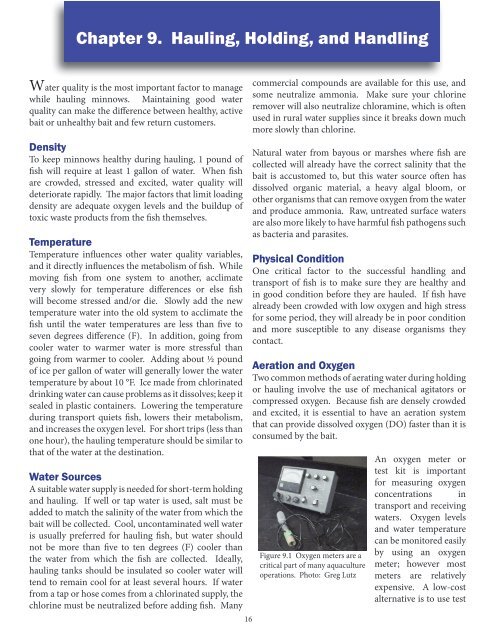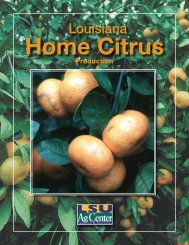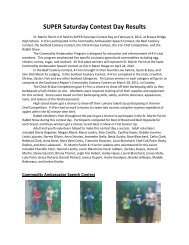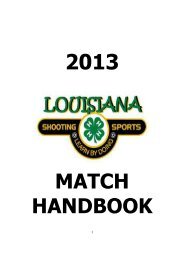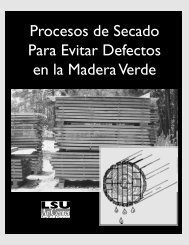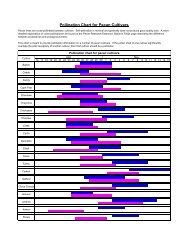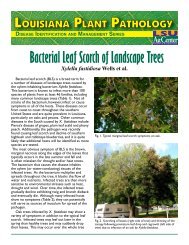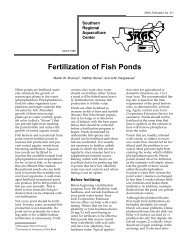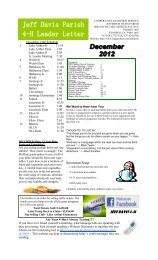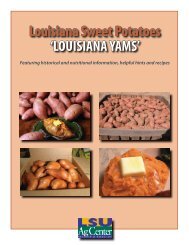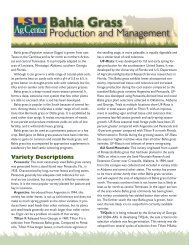Cocahoe Minnow - The LSU AgCenter
Cocahoe Minnow - The LSU AgCenter
Cocahoe Minnow - The LSU AgCenter
Create successful ePaper yourself
Turn your PDF publications into a flip-book with our unique Google optimized e-Paper software.
Chapter 9. Hauling, Holding, and Handling<br />
Water quality is the most important factor to manage<br />
while hauling minnows. Maintaining good water<br />
quality can make the difference between healthy, active<br />
bait or unhealthy bait and few return customers.<br />
Density<br />
To keep minnows healthy during hauling, 1 pound of<br />
fish will require at least 1 gallon of water. When fish<br />
are crowded, stressed and excited, water quality will<br />
deteriorate rapidly. <strong>The</strong> major factors that limit loading<br />
density are adequate oxygen levels and the buildup of<br />
toxic waste products from the fish themselves.<br />
Temperature<br />
Temperature influences other water quality variables,<br />
and it directly influences the metabolism of fish. While<br />
moving fish from one system to another, acclimate<br />
very slowly for temperature differences or else fish<br />
will become stressed and/or die. Slowly add the new<br />
temperature water into the old system to acclimate the<br />
fish until the water temperatures are less than five to<br />
seven degrees difference (F). In addition, going from<br />
cooler water to warmer water is more stressful than<br />
going from warmer to cooler. Adding about ½ pound<br />
of ice per gallon of water will generally lower the water<br />
temperature by about 10 °F. Ice made from chlorinated<br />
drinking water can cause problems as it dissolves; keep it<br />
sealed in plastic containers. Lowering the temperature<br />
during transport quiets fish, lowers their metabolism,<br />
and increases the oxygen level. For short trips (less than<br />
one hour), the hauling temperature should be similar to<br />
that of the water at the destination.<br />
Water Sources<br />
A suitable water supply is needed for short-term holding<br />
and hauling. If well or tap water is used, salt must be<br />
added to match the salinity of the water from which the<br />
bait will be collected. Cool, uncontaminated well water<br />
is usually preferred for hauling fish, but water should<br />
not be more than five to ten degrees (F) cooler than<br />
the water from which the fish are collected. Ideally,<br />
hauling tanks should be insulated so cooler water will<br />
tend to remain cool for at least several hours. If water<br />
from a tap or hose comes from a chlorinated supply, the<br />
chlorine must be neutralized before adding fish. Many<br />
16<br />
commercial compounds are available for this use, and<br />
some neutralize ammonia. Make sure your chlorine<br />
remover will also neutralize chloramine, which is often<br />
used in rural water supplies since it breaks down much<br />
more slowly than chlorine.<br />
Natural water from bayous or marshes where fish are<br />
collected will already have the correct salinity that the<br />
bait is accustomed to, but this water source often has<br />
dissolved organic material, a heavy algal bloom, or<br />
other organisms that can remove oxygen from the water<br />
and produce ammonia. Raw, untreated surface waters<br />
are also more likely to have harmful fish pathogens such<br />
as bacteria and parasites.<br />
Physical Condition<br />
One critical factor to the successful handling and<br />
transport of fish is to make sure they are healthy and<br />
in good condition before they are hauled. If fish have<br />
already been crowded with low oxygen and high stress<br />
for some period, they will already be in poor condition<br />
and more susceptible to any disease organisms they<br />
contact.<br />
Aeration and Oxygen<br />
Two common methods of aerating water during holding<br />
or hauling involve the use of mechanical agitators or<br />
compressed oxygen. Because fish are densely crowded<br />
and excited, it is essential to have an aeration system<br />
that can provide dissolved oxygen (DO) faster than it is<br />
consumed by the bait.<br />
Figure 9.1 Oxygen meters are a<br />
critical part of many aquaculture<br />
operations. Photo: Greg Lutz<br />
An oxygen meter or<br />
test kit is important<br />
for measuring oxygen<br />
concentrations in<br />
transport and receiving<br />
waters. Oxygen levels<br />
and water temperature<br />
can be monitored easily<br />
by using an oxygen<br />
meter; however most<br />
meters are relatively<br />
expensive. A low-cost<br />
alternative is to use test


